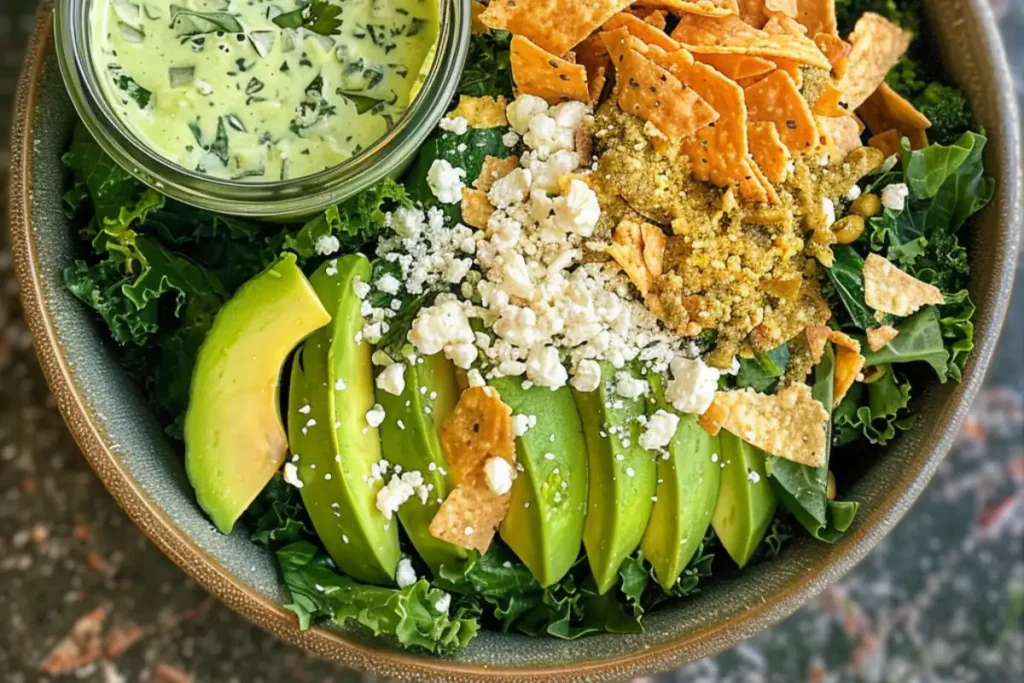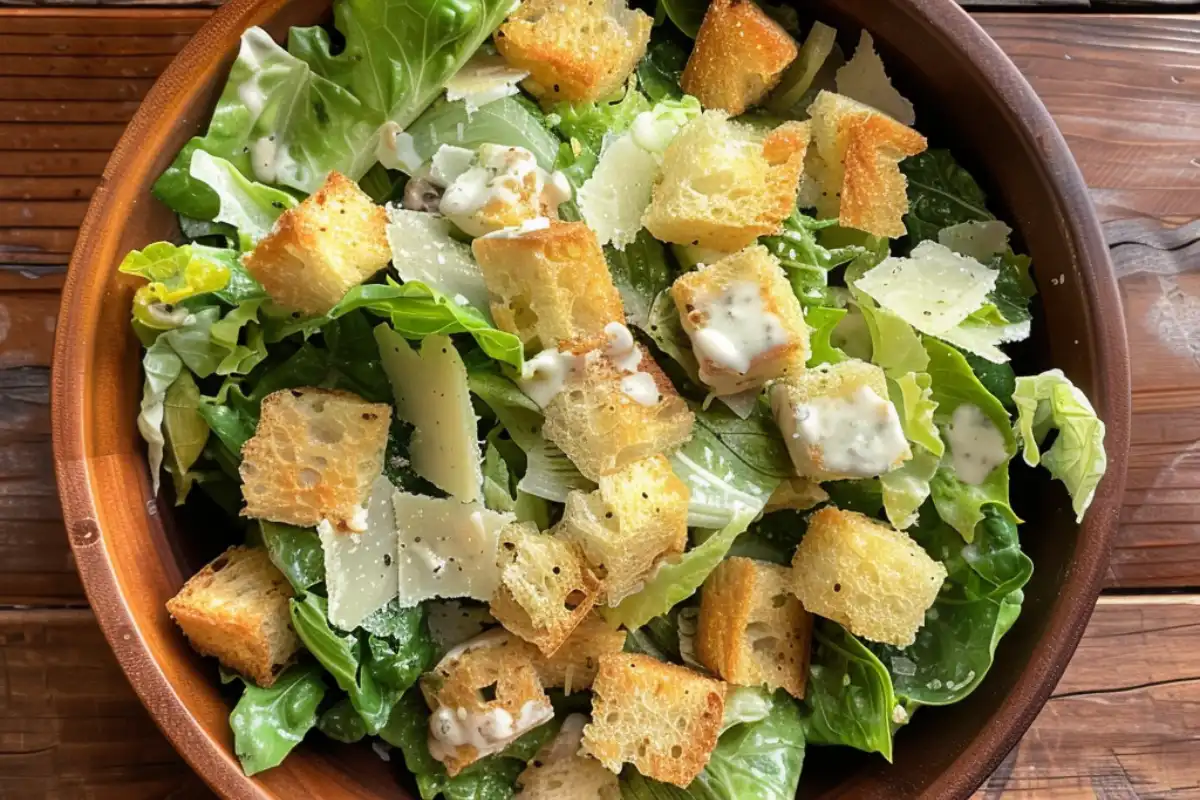Caesar salad is one of the most iconic dishes served worldwide, loved for its combination of crisp romaine lettuce, creamy dressing, crunchy croutons, and a savory kick from Parmesan cheese. However, the question of its origin remains a point of debate: Is Caesar salad a Mexican dish?
This question might seem strange to those familiar with the Italian-inspired ingredients of Caesar salad. However, this global favorite has deep roots in Tijuana, Mexico. This article explores the fascinating origins of Caesar salad, the cultural and culinary context that gave birth to it, and how it has evolved to become a beloved dish worldwide.
The Origins of Caesar Salad: Italian or Mexican?
Caesar salad contains quintessential Italian ingredients like Parmesan cheese and olive oil. However, its story begins in Tijuana, Mexico. An Italian immigrant, Caesar Cardini, created the salad in the 1920s during a time of bustling American tourism. Cardini ran a popular restaurant in Tijuana, where American tourists flocked to escape the restrictions of Prohibition.
Caesar Cardini: The Creator Behind the Salad
Caesar Cardini, an Italian immigrant, opened his restaurant in Tijuana to serve a mixed clientele of locals and tourists from the U.S. On July 4th, 1924, during a busy holiday weekend, the kitchen ran low on supplies, forcing Cardini to improvise. Using the ingredients available—romaine lettuce, garlic, olive oil, egg yolks, Parmesan cheese, and Worcestershire sauce—he crafted what we now know as Caesar salad.
Despite the Italian nature of the ingredients, the salad was created, prepared, and first served in Tijuana, making it a dish with distinctly Mexican roots. Caesar’s Restaurant in Tijuana still serves the original salad today, offering tourists a taste of history.
A Blend of Italian and Mexican Influences
Although the salad’s ingredients—like olive oil and Parmesan cheese—come from Italian cooking traditions, its origin in Tijuana gives it a Mexican twist. The local resources, American tourists, and Mexico’s burgeoning culinary scene allowed Caesar Cardini to create something unique. While not traditionally Mexican, Caesar salad reflects Tijuana’s fusion cuisine.
The interactive presentation style of serving the salad tableside, with the waiter mixing the dressing in front of guests, is part of what made it so popular among tourists. This hands-on dining experience is still a hallmark of Mexican hospitality, which adds another layer to its Mexican identity.
You can also explore the surprising roots of Caesar salad in BBC’s article, The Mexican Origins of Caesar Salad, which covers the cultural significance and journey of the dish.
Traditional Caesar Salad Ingredients: Mexican or Italian?
Understanding whether Caesar salad can be classified as a Mexican dish requires examining its ingredients. Though many assume it’s Italian, its Tijuana roots complicate the narrative.
Classic Ingredients
The original Caesar salad, as conceived by Caesar Cardini, contained:
- Romaine lettuce: Crisp and slightly bitter, forming the base of the salad.
- Olive oil: A staple in Italian cuisine, used to create the creamy dressing.
- Garlic: Common in both Italian and Mexican cooking.
- Parmesan cheese: A hard, salty cheese originating from Italy, demonstrating the influence of Italian ingredients in global cuisine (The Spruce Eats).
- Worcestershire sauce: A British condiment made from fermented anchovies, contributing a savory, umami flavor.
- Croutons: Fried or toasted bread cubes, adding texture to the salad.
Although none of these ingredients scream “Mexican,” the salad’s simplicity and resourcefulness reflect the essence of Mexican cuisine. In Tijuana during the 1920s, many of these ingredients were readily available due to the city’s proximity to the U.S. and its exposure to international trade. This accessibility, combined with Mexican hospitality, allowed Caesar salad to thrive.
For a breakdown of how different ingredients impact flavor in classic dishes, check out our guide on How to Choose the Right Sugar for Desserts, where we explore ingredient selection in depth.

Mexican Influence on Preparation and Presentation
Even though the ingredients might seem European, the salad’s creation in Tijuana and its method of preparation lend it a Mexican identity. Servers famously prepared the salad tableside, following a tradition that reflects Mexican dining culture, where food presentation and interaction with guests play a key role. This highlights the importance of food presentation in dining (Fine Dining Lovers)
How Caesar Salad Gained Popularity Worldwide
After its creation in Tijuana, Caesar salad didn’t take long to spread beyond Mexico. Its rise to fame can be attributed to American tourism and the influence of Hollywood, which helped turn the dish into a global culinary sensation.
The Role of American Tourists in Caesar Salad’s Spread
In the 1920s, Tijuana was a prime destination for Americans seeking to escape Prohibition in the U.S. Many of these tourists dined at Caesar’s Restaurant and fell in love with the tableside-prepared salad. After returning home, they spread the word about this delicious new dish they had tasted in Mexico.
The cross-border exchange of culinary ideas helped push Caesar salad into American restaurants, where chefs began serving it as a staple on their menus. The appeal of a simple yet elegant salad made it particularly popular among fine dining establishments.
Hollywood’s Role in Popularizing Caesar Salad
Hollywood celebrities also played a major role in elevating the status of Caesar salad. Stars like Clark Gable and Jean Harlow were known to dine at Caesar’s Restaurant in Tijuana, bringing even more attention to the dish. This celebrity endorsement helped cement the salad as a trendy dish during its early years.
As a result of this influence, Caesar salad quickly made its way into U.S. restaurants and eventually around the world, evolving into the dish we know today. For more on the cultural history of Caesar salad, check out Lola’s Cocina and their take on the Original Caesar Salad.
The Cultural Significance of Caesar Salad in Mexico
Despite being a global favorite, Caesar salad holds a special place in Mexican culinary history. Its origins in Tijuana tie it directly to Mexico’s vibrant food culture, and it remains a point of pride for the city.
Tijuana’s Culinary Heritage
Tijuana has become a hub for culinary fusion, where international flavors meet Mexican traditions. Caesar salad, with its blend of Italian ingredients and Mexican hospitality, embodies this fusion. Tourists continue to visit Tijuana to enjoy the original Caesar salad at Caesar’s Restaurant, where they can experience the dish as it was first created.
Comparing Caesar Salad to Traditional Mexican Dishes
Even though Caesar salad was created in Tijuana, it differs significantly from what most would consider traditional Mexican cuisine. Let’s compare it to some classic Mexican salads to understand where it stands.
Caesar Salad vs. Mexican Salads
Traditional Mexican salads, such as ensalada de nopales (cactus salad) and ensalada mixta (mixed salad), usually include ingredients like avocado, tomatoes, beans, and nopales. These salads are often spiced with chilies and dressed with lime juice or cilantro. In contrast, Caesar salad’s key ingredients—Parmesan cheese and Worcestershire sauce—are European. This gives it a different flavor profile compared to typical Mexican salads.

To see another modern fusion of Mexican and European cuisines, check out this recipe for Street Corn Pasta Salad. It combines Mexican street food flavors with a classic pasta salad
Debunking Myths: Common Misconceptions About Caesar Salad’s Origins
Over the years, many misconceptions have circulated about the origins of Caesar salad. Let’s clarify a few of the most common myths.
The Italian Myth
Many assume that Caesar salad is an Italian dish due to the presence of Parmesan cheese and olive oil. While Caesar Cardini was Italian by birth, the salad was created in Mexico. Its ingredients reflect his Italian heritage, but the dish itself is part of Mexico’s culinary story.
The American Misconception
Another common belief is that Caesar salad is an American invention, perhaps due to its widespread popularity in the U.S. While it did gain fame through American tourists and Hollywood celebrities, its origin is firmly planted in Tijuana, Mexico.
For more insights into cross-cultural culinary influences, check out our guide on how Mexican Corn Dishes Evolved, which explores how Mexican ingredients have traveled across borders.
Is Caesar Salad Considered a Mexican Dish Today?
Even though Caesar salad has become a globally recognized dish, it still holds a unique place in Mexican culinary history. While it may not be a traditional Mexican dish like tacos or enchiladas, its creation in Tijuana secures its place as part of Mexico’s food legacy.
Global Identity with Mexican Roots
Although many people often see it as an international dish, Caesar salad remains deeply connected to its Mexican origins. Caesar Cardini created the salad in Tijuana, where it attracted tourists and gained worldwide fame, making it one of Mexico’s significant contributions to global cuisine.
FAQs About Caesar Salad’s Origin
Is Caesar salad Italian or Mexican?
- Caesar salad is a Mexican dish created by Caesar Cardini in Tijuana, Mexico. While its ingredients have Italian influences, its creation and first service were in Mexico.
Who invented Caesar salad?
- Caesar Cardini invented the salad in 1924 at his restaurant in Tijuana
Why is Caesar salad considered a Mexican dish?
- Despite its European ingredients, Caesar salad was first created and served in Mexico, making it a part of the country’s culinary heritage.
Where was Caesar salad first served?
- Caesar salad was first served at Caesar’s Restaurant in Tijuana, Mexico, which is still in operation today.
Conclusion: The Legacy of Caesar Salad
So, is Caesar salad a Mexican dish? The answer is yes—with a twist. While it incorporates Italian ingredients, its creation and global success began in Tijuana, Mexico. Today, Caesar salad is a symbol of how food can transcend borders and cultures. Whether you’re enjoying it in a fine dining restaurant or making it at home, the dish’s origins will always be rooted in the vibrant culinary history of Mexico.

